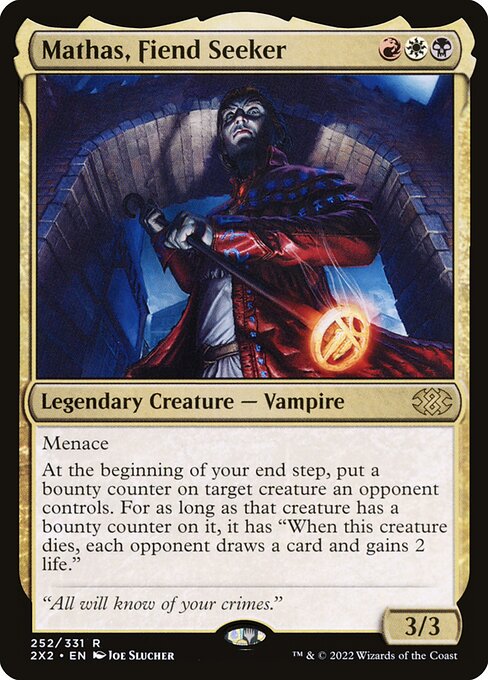
Image courtesy of Scryfall.com
Intertextuality in Magic: The Gathering
Magic’s storytelling isn’t contained to a single epic; it’s a living conversation that threads through past sets, mythic motifs, and the designers’ clever nods to the game’s own history. Intertextuality in MTG is the art of making a card feel part of a larger tapestry—where a creature’s design, a flavor line, or a mechanic evokes something familiar while inviting new strategies. When you glance at Mathas, Fiend Seeker, you’re stepping into that conversation: a tri-color vampire with a memorable mechanic that reframes how we think about board presence, risk, and reward. The card reminds us that the longest stories are the ones told across several game sessions, across formats, and across the table as players negotiate, bluff, and chase a shared win 🧙♂️🔥💎.
Mathas, Fiend Seeker: a tri-color political vampire
Costing {R}{W}{B}, Mathas sits at the unusual crossroads of red, white, and black mana—a trio that signals speed, order, and hunger all at once. The menace keyword ensures Mathas applies pressure from the moment it hits the battlefield, but its real genius lies in the end-step ability: At the beginning of your end step, put a bounty counter on target creature an opponent controls. For as long as that creature has a bounty counter on it, it has "When this creature dies, each opponent draws a card and gains 2 life." This isn’t just a line of text; it’s a narrative loom that ties power, consequence, and social play into a single moment on the table. The flavor text—
All will know of your crimes.—reads as a ominous aside from a predator who loves to choreograph chaos as much as he loves the chase 🧙♂️⚔️.
The color trio makes a statement beyond the card’s numbers. Red’s impulsive menace meets White’s calculated influence and Black’s capitalized cost—creating a synthwave of ambition that thrives in multiplayer environments like Commander. Mathas doesn’t simply attack; he invites a conversation about who controls the table’s narrative. When a bounty counter lands on a creature controlled by an opponent, you’re not just removing a blocker or dealing damage; you’re injecting a strategic dilemma into every exchange: do we eliminate the bounty target and risk giving opponents a card and life swing, or do we let it linger and risk the creature becoming a liability closer to the late game? That choice—consistently faced at the table—embodies why this card feels so intertextual: its mechanics speak in conversation with vampire lore, political play, and the ethics of “the best move” in a high-stakes, social game 🧙♂️🎲.
Intertextual threads: bounty, consequence, and the broader narrative
The bounty mechanic is a house-designed storytelling device that resonates with classic vampire narratives: power is negotiated, threats are calculated, and death carries a communal consequence. In a multiplayer format, the line “When this creature dies, each opponent draws a card and gains 2 life” reshapes the expected calculus of combat. It’s not just about removing a threat; it’s about who benefits from that removal, who gains information, and how the table responds to the shifting power balance. The mechanic’s presence in a Double Masters 2022 reprint further enhances its intertextual resonance—cards reappearing, looping ideas, and inviting players to see familiar concepts (bounty dynamics, political plays, and vampire-flavored risk) reinterpreted through a modern lens 🧙♂️🎨.
From a design perspective, Mathas demonstrates how flavor and function can reinforce one another. Joe Slucher’s portrayal of a charismatic, dangerous figure matches the card’s textual menace, giving players a strong mental image of a noble predator orchestrating a game of secrets and incentives. The set’s collector-friendly presence—foil and non-foil options, together with a rare slot in a high-profile reprint line—ensures that the card isn’t just a game piece but a memory-laden artifact of contemporary MTG culture. The resulting synergy between flavor text, mechanics, and artwork makes Mathas a standout case study in how intertextual elements can elevate a card from a playable asset to a story engine 🧩💎.
Strategies, synergy, and the play culture around Mathas
In practical terms, Mathas rewards players who enjoy the political dimension of multiplayer formats. A deft hand with mana and positioning can place a bounty counter on a crucial opposing creature, triggering a cascade that invites negotiation, table-talk, and dramatic comebacks. The tri-color identity demands a careful mana base—think shock lands, fetches, and a resilient suite of mana ramp and disruption—to keep the pressure on while you protect Mathas itself. The card’s rarity and reprint status make it accessible for casual players and collectors alike, while its flavor-forward design compels you to consider not just what a card does, but what it says about the world in which it exists 🧙♂️💬.
For collectors, the card’s Double Masters 2022 pedigree adds a layer of nostalgia with a modern twist. The flavor text—paired with a bold mechanical concept—ensures Mathas remains memorable even when it’s not on the battlefield. The combination of a potent end-step effect and the potential to redraw the political map of a game makes Mathas a prime candidate for build-around strategies in Commander, where three-color access and long, dramatic games are the norm. It’s not just a creature; it’s a lever you can pull to invite new stories to the table 🧙♂️💥.
Rectangular Gaming Mouse Pad Non-Slip Rubber Base 1/16 Inch ThickMore from our network
- https://crypto-acolytes.xyz/blog/post/key-solana-partnerships-shaping-the-future-of-web3/
- https://blog.digital-vault.xyz/blog/post/distant-hot-giant-sheds-light-on-star-formation-in-galactic-arms/
- https://crypto-acolytes.xyz/blog/post/nft-driven-game-economies-boom-or-bust/
- https://crypto-acolytes.xyz/blog/post/solana-rpc-node-explained-what-it-does-and-why-it-matters/
- https://blog.digital-vault.xyz/blog/post/comparing-shaymin-land-spawn-rates-across-generations/